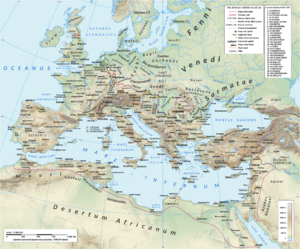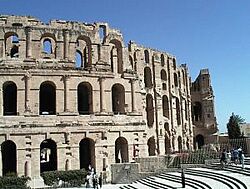Africa Province facts for kids
Quick facts for kids Africa Proconsularis |
|||||||||||
|---|---|---|---|---|---|---|---|---|---|---|---|
| Province of the Roman Republic and Roman Empire | |||||||||||
| 146 BC–AD 439 534–698 |
|||||||||||
 The province of Africa within the Roman Empire |
|||||||||||
| Capital | Zama Regia, Utica, then Carthago | ||||||||||
| Historical era | Classical antiquity-Late antiquity-Early Middle Ages | ||||||||||
|
• Established after the Third Punic War
|
146 BC | ||||||||||
| 439 AD | |||||||||||
|
• Byzantine reconquest by Vandalic War
|
534 | ||||||||||
|
• Reorganization into the Exarchate
|
591 | ||||||||||
|
• Fall of Carthage
|
698 | ||||||||||
|
|||||||||||
| Today part of | Tunisia Libya Algeria |
||||||||||
Africa was an important Roman province located on the northern coast of the continent of Africa. It was created in 146 BC. This happened after the Roman Republic defeated Carthage in the Third Punic War.
The province covered most of what is now Tunisia. It also included parts of northeastern Algeria and the western coast of Libya. The original people living here were the Berbers, also known as the Mauri in Latin. Around the 9th century BC, Phoenicians from West Asia built settlements along the Mediterranean Sea coast. These settlements helped with shipping. Carthage became the most powerful of these cities in the 8th century BC.
Roman Africa was one of the richest provinces in the western part of the Roman Empire. Only Italy was wealthier. Besides Carthage, other big cities in the province included Hadrumetum (today's Sousse, Tunisia) and Hippo Regius (today's Annaba, Algeria).
Contents
History of Roman Africa
The Romans created their first province in northern Africa in 146 BC. This was after Scipio Aemilianus conquered Carthage in the Third Punic War.
Utica became the capital city. Utica had supported the Romans during the war. The rest of the land was left to the Berber Numidian king, Massinissa. At first, Rome just wanted to stop any other strong power from growing in Northwest Africa.
In 118 BC, a Numidian prince named Jugurtha tried to unite the smaller kingdoms. But after his death, much of his land went to the Berber king Bocchus. By then, Roman culture was already strong in Africa.
During Caesar's civil war, Julius Caesar created a new African province. He took land from the Numidians to do this. The first province was called Africa Vetus (Old Africa). The new one was called Africa Nova (New Africa). Later, around 35 BC, these two provinces were combined. This happened because of border fights.
The province continued to grow under Emperor Augustus. By 27 BC, Africa became a "senatorial province." This meant it was ruled by a proconsul, a high-ranking Roman official. It was then known as Africa Proconsularis.
After Emperor Diocletian changed the Roman government, the province was split. It became Africa Zeugitana (still called Africa Proconsularis) in the north. To its south was Africa Byzacena (eastern Tunisia). Further south was Africa Tripolitania (southern Tunisia and northwest Libya). All these parts were in the Dioecesis Africae.
The region stayed part of the Roman Empire until the 400s AD. In 429 AD, the Vandals, a Germanic group, crossed from Spain into Northwest Africa. They took over the area by 439 AD. They created their own kingdom, which also included Sicily, Corsica, Sardinia, and the Balearics. The Vandals ruled as a warrior group. But they faced strong resistance from the local Berbers.
In 533 AD, Emperor Justinian sent an army led by General Belisarius to take Africa back. In a short war, Belisarius defeated the Vandals. He entered Carthage in victory and brought the province back under Roman rule. The Romans then built many forts. This helped them control the area and push back against attacks from desert tribes.
The provinces in northwest Africa were later grouped together. They became the Exarchate of Africa under Emperor Maurice. This area did well. In 610 AD, Heraclius even overthrew Emperor Phocas from here. Heraclius even thought about moving the capital of the empire from Constantinople to Carthage.
After 640 AD, the Exarchate tried to stop the Muslim conquest. But in 698 AD, a Muslim army from Egypt attacked Carthage. They conquered the Exarchate. This ended Roman and Christian rule in Northwest Africa.
People of Roman Africa
The Roman army in Northwest Africa was not very large. It had about 28,000 soldiers. From the 2nd century AD, most of these soldiers were local people. A large number of Latin-speaking people grew in the region. They came from many different backgrounds. They lived alongside people who spoke Punic and Berber languages. Even the local Berbers joined the Roman security forces.
Historian Abun-Nasr said that Berbers accepted the Roman way of life easily. This was because the Romans were tolerant of Berber religions. This was true even though the Romans had conquered their lands. However, Roman culture did not reach every part of Africa equally. Some Berber groups remained non-Romanized, even in areas like Tunisia and Numidia, where Roman culture was very strong.
By the end of the Western Roman Empire, almost all of the Maghreb region had adopted Roman culture. This made Roman Africans very prosperous. This wealth and Roman way of life even reached people living outside the Roman borders.
Many famous Roman Africans came from this region. These included the writer Terence, the lawyer Salvius Julianus, the novelist Apuleius, and the emperor Septimius Severus. Important Christian figures like Tertullian, Cyprian, and Augustine of Thagaste also came from Roman Africa.
Economy of Roman Africa
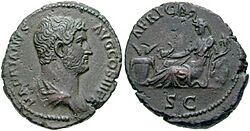
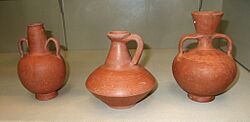
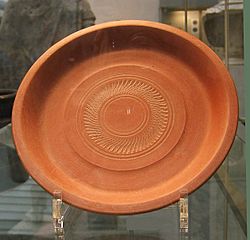
The wealth of most towns in Roman Africa came from farming. The region was called the "granary of the empire." It produced about one million tons of grain each year. A quarter of this was sent to other parts of the empire. Other crops included beans, figs, grapes, and fruits. By the 2nd century, olive oil became as important as grain for export.
Besides farming, the region also produced textiles, marble, wine, wood, and wool. They also captured and exported exotic wild animals. Pottery, like African Red Slip, was another major export.
When cities became part of the Roman Empire, they grew very quickly. This led to more workshops and businesses in the cities. As Rome's population grew, it needed more goods from Northwest Africa. This busy trade helped the cities in the region grow and become well-organized centers. Many Roman cities were both places where goods were made and where they were bought and sold.
City people started working more in crafts and services. They worked less in farming. This meant that a lot of the city's money came from selling products. These products were sold through traders to markets in the countryside and abroad. Changes in how farm products were processed, like olive oil and wine, also helped cities and trade grow. The quality and demand for these products were highest in Roman Northwest Africa.
Pottery Production
Northwest Africa had many olive farms and clay sources. This helped it become a major center for making fine Ancient Roman pottery. They were especially known for African Red Slip terra sigillata tableware and clay oil lamps. Lamps were the most common way to light homes and public places in Rome. They were also used in temples and for festivals.
As the craft improved, African pottery became as good as, or even better than, pottery from Italy and Greece. Around the 1st century BC, new ways of using molds allowed for many different shapes and decorations. The skill of the lamp maker was seen in the quality of the designs on the top and rim of the lamp.
The process of making lamps involved several steps. Small molds were used to create decorative patterns. These patterns were then added to a plain lamp shape. This decorated lamp was then used to make two plaster molds (top and bottom). Then, many copies could be made quickly. The decorations varied based on the lamp's use and popular styles.
Later, patterns of squares and circles were added to the rim. There were also designs of palm trees, small fish, animals, and flowers. The top of the lamp often showed gods, goddesses, myths, daily life scenes, and nature. After the Roman period, Christian symbols like saints, crosses, and Bible figures became common on lamps. Older mythological symbols also remained popular, showing the region's Punic history. Many early African lamps have the maker's name on the base. This shows that there was a strong and competitive market for these goods.
African Terra Sigillata
After a period of decline in the 3rd century AD, lamp-making became popular again. This was helped by the use of fine local red clays in the late 4th century. African Red Slip ware (ARS), also called African Terra Sigillata, changed the pottery and lamp-making industry.
ARS ware was made from the late 1st century AD onwards. It was very important in the middle and late Roman periods. It was known as "fine" or high-quality tableware. It was sold locally and across the Mediterranean Sea through busy trade routes. Northwest Africa's economy grew as its products spread and demand increased.
At first, ARS lamp designs were simple. But more detailed designs appeared before the early 5th century as demand grew. The spread of ARS fine pottery marks the most unique time for pottery-making in Northwest Africa.
These special pottery lamps were made in large amounts by well-organized factories. Scientists can tell where they came from by studying the clay. This helps archaeologists track how they were sold from their source across the Mediterranean. Some major ARS centers in central Tunisia were Sidi Marzouk Tounsi, Henchir el-Guellal (Djilma), and Henchir es-Srira.
Local pottery markets helped the economy of towns and the whole region. They also supported markets abroad. Certain pottery shapes, materials, and decorations were unique to specific regions or even pottery centers. If a piece of pottery cannot be identified by its shape or decoration, scientists can use chemical analysis. This can trace it back to its exact place of production.
Forests and Economy
Pine forests were common and important for the economy. Especially in the wet areas of modern Tunisia. These areas were often called saltus, meaning land used for things other than farming. Wood, pitch (used to waterproof ships), firewood, pine nuts, and charcoal were all produced. Animals also grazed in these forests.
Olive farms were also widespread, often on land that was once forest. The leftover pulp from making olive oil was used as fuel. Temples, like the one for Mercury Silvius (a god of trade linked to forests) in Dougga, show how important forests were to local trade.
Christianity
See Also
 In Spanish: África (provincia romana) para niños
In Spanish: África (provincia romana) para niños
- List of Roman governors of Africa
- Ifriqiya
- African Romance
- Lex Manciana
- Fossatum Africae
- Roman limes
- Roman roads in Africa
- Kingdom of Africa
- Byzantine North Africa


